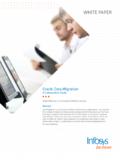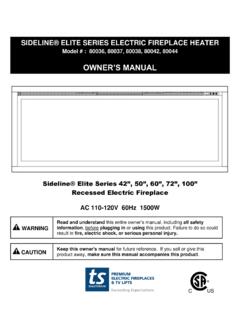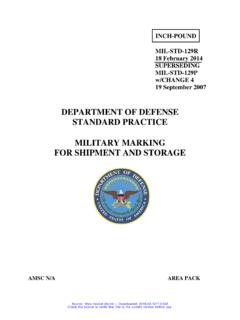Transcription of PHARMACEUTICAL SERIALIZATION TRACK & TRACE
1 PHARMACEUTICAL SERIALIZATION TRACK & TRACEEASY GUIDE TO COUNTRY- WISE MANDATESE xternal Document 2018 Infosys LimitedExternal Document 2018 Infosys LimitedExternal Document 2018 Infosys LimitedExternal Document 2018 Infosys LimitedTable of ContentsIntroduction 05US Federal 06 California 08 Argentina 10 Brazil 12 South Korea 14 India 16 China 18EU 20 France 22 Turkey 24 References 26 External Document 2018 Infosys LimitedExternal Document 2018 Infosys LimitedIntroductionPharmaceutical companies have to contend with challenges stemming from supply chain security lapses (resulting in theft, diversion and product recalls), counterfeiting and stringent regulations. In addition to alarming safety concerns, these challenges also impair the health of the industry by adversely impacting profits, brand credibility and research initiatives. With both industry and governments around the world realizing the significance of implementing product SERIALIZATION , it becomes mandatory for all entities within the supply chain to comply with federal and/or state legislations pertaining to the locations in which they , drug distribution systems consist of entities such as manufacturers, wholesale distributors and pharmacies before products reach the end consumer.
2 Ensuring secure product TRACK and TRACE capabilities across various touch points throughout the supply chain - through product SERIALIZATION implementation - is crucial to address the challenges faced by the industry. Apart from providing visibility and full traceability within the supply chain, successful SERIALIZATION programs will prove to be a key differentiator and a clear competitive advantage for PHARMACEUTICAL guide, compiled by the Legal and Research team at the Infosys Life Sciences Center of Excellence provides a summary of the legal and regulatory framework proposed by countries including Argentina, Brazil, China, EU, France, India, South Korea, Turkey, and USA (Federal and California) to maintain supply chain integrity and ensure patient safety. This guide also provides information on mandates to be adhered to by various stakeholders, to ensure regulatory compliance.
3 We look forward to further discussing this research with you. External Document 2018 Infosys LimitedUS FederalDrug Quality and Security Act - 3204 The Drug Quality and Security Act - 3204 was introduced on September 27, 2013. This bill was passed in the House on September 28, 2013 - also referred as Pharma TRACK and TRACE bill - is approved by Senate as a US federal law effective Nov 27, Drug Quality and Security Act would address the following two important issues affecting the quality and security of America s drug supply:1. Protect traditional pharmacies and clarify laws related to human drug compounding in response to the nationwide meningitis outbreak one of the largest public health crises in recent Strengthening of prescription drug supply chain in order to defend American families against counterfeit drugs and protect bill is supported by the National Community Pharmacists Association, Chamber of Commerce, UPS, PhRMA, GPhA, BIO, HDMA, HIDA, NACDS and many other is the detailed mandate requirements and their respective timelines:External Document 2018 Infosys LimitedTitle 2 - Drug Supply Chain Security ActTitle II of the Drug Quality and Security Act, which is based on Rep.
4 Bob Latta s (R-OH) 1919, would create a uniform national standard for drug supply chain security to protect Americans against counterfeit drugs while eliminating needless government red tape. The bill also would help prevent increases in drug prices, avoid additional drug shortages and eliminate hundreds of millions of dollars worth of duplicative government regulations on American drug manufacturers, wholesale distributors, pharmacies, repackagers and third-party logistic providers. The bill would:This bill would enable the following:1. Create a new framework for securing our prescription drug supply chain. The bill also would establish a 10-year transition to a unit level tracking system for enhanced Eliminate the patchwork of red tape, like California s pedigree law, on drug manufacturers, wholesale distributors, pharmacies, repackagers, and third-party logistic providers (3 PLs).
5 These changes would help alleviate drug shortages and reduce government-imposed costs on prescription Create floor and ceiling licensure standards for wholesale distributors and 3 PLs while preserving state authority for licensure issuance and fee 1 - Compounding Quality ActTitle I of the Drug Quality and Security Act, which is based on Rep. Morgan Griffith s (R-VA) 3089 and the Energy and Commerce Committee s investigation of the meningitis outbreak (including four committee hearings), would clarify FDA s authority over the compounding of human drugs while requiring the agency to engage and coordinate with states to ensure the safety of compounded bill would enable the following:1. Preserve and protect the practice of traditional pharmacy compounding occurring in community Eliminate the unconstitutional provisions of Section 503A of the Federal Food, Drug, and Cosmetic Act (FFDCA) that created uncertainty regarding the laws governing compounding and require FDA to engage in two-way communication with state regulators a major deficiency in FDA s response to the meningitis Permit entities engaged in the compounding of sterile drugs to register as outsourcing facilities.
6 External Document 2018 Infosys LimitedCaliforniaCalifornia s E-Pedigree Law PreemptedOn November 27, 2013, President Obama signed Public Law 113-54. This law contains provisions for a national TRACK and TRACE system for prescription medication. Included within this law are provisions that preempt California s e-pedigree requirements. These provisions are in addition to those in the California Business and Professions Code that also preempt California s provisions should federal legislation in this area be California Board of Pharmacy made it official late this afternoon, February 10th, 2014. As required by Section of the California Business and Professions Code (CB&PC), the Board posted a public notice late yesterday indicating that sections 4034, 4163, , , , and of the CB&PC became inoperative due to the enactment of the Federal Drug Quality and Security Act (DQSA) on November 27, 2013 (see It s Official, President Obama Signs 3204, DQSA, Into Law ).
7 These specific sections of the CB&PC comprise what has been referred to in the industry as the California Pedigree Law .The public notice was mandated by California law within 90 days of federal Document 2018 Infosys LimitedCompliance Mandate The pedigree shall be created and maintained in an interoperable electronic system, ensuring compatibility throughout all stages of distribution. A pedigree shall include all of the following information: The source of the dangerous drug, including the name, the federal manufacturer s registration number or a state license number as determined by the board, and principal address of the source. The trade or generic name of the drug, the quantity of the dangerous drug, its dosage form and strength, the date of the transaction, the sales invoice number, the container size, the number of containers, the expiration dates, and the lot numbers.
8 The business name, address, and the federal manufacturer s registration number or a state license number as determined by the board, of each owner of the dangerous drug, and the dangerous drug shipping information, including the name and address of each person certifying delivery or receipt of the dangerous drug. A certification under penalty of perjury from a responsible party of the source of the dangerous drug that the information contained in the pedigree is true and accurate. A single pedigree shall include every change of ownership of a given dangerous drug from its initial manufacture through to its final transaction to a pharmacy or other person for furnishing, administering, or dispensing the drug, regardless of repackaging or assignment of another National Drug Code (NDC) Directory number. A pedigree shall TRACK each dangerous drug at the smallest package or immediate container distributed by the manufacturer, received and distributed by the wholesaler, and received by the pharmacy or another person furnishing, administering, or dispensing the dangerous drug.
9 Any return of a dangerous drug to a wholesaler or manufacturer shall be documented on the same pedigree as the transaction that resulted in the receipt of the drug by the party returning it. If a manufacturer, wholesaler, or pharmacy has reasonable cause to believe that a dangerous drug in, or having been in, its possession is counterfeit or the subject of a fraudulent transaction, the manufacturer, wholesaler, or pharmacy shall notify the board within 72 hours of obtaining that Document 2018 Infosys LimitedArgentinaSummary of the Law The National Food, Drug and Technology Administration (ANMAT), through the Regulation 3683, has chosen GS1 Standards to distinctively identify drugs through the supply chain. Under the regulation, each unit has to be given a unique identifier that includes a batch number and expiration date, allowing the product to be monitored in the supply chain.
10 A distinctive feature of the legislation is the inclusion of new categories of drugs over a period of time. On March 28, 2012, ANMAT added new drug classes to the traceability scheme, including antibiotics, insulin, clotting factors and a broad range of cardiovascular drugs and central nervous system treatments including antidepressants, antipsychotics and drugs for epilepsy and Parkinson s disease. Again, in 2013, the government added more than 200 additional drugs to the traceability system. The government plans to implement the SERIALIZATION program on a phased approach with more drugs and agents being added to the system. The Argentine authority tasked with combating illegal narcotics, SEDRONAR, launched a national chemical precursors traceability system on 1 January 2013. The system will enable operators to digitally record precursor transactions nationwide via a computer network, while allowing regulators real-time monitoring of precursor movements, and the gathering and collection of such data for Document 2018 Infosys LimitedCompliance Mandate PHARMACEUTICAL companies must place a support or storing device with capacity to store a univocal code supervised and audited by ANMAT on the package of each of unit of a medicinal product for sale to the public.













